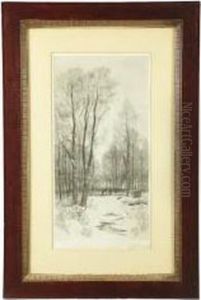Mielatz Paintings
Charles Frederick William Mielatz, commonly known as Charles Mielatz, was an American artist known for his etchings and his role in popularizing this art form in the United States. Born on August 24, 1860, in Breddin, Germany, Mielatz immigrated to the United States at a young age. Throughout his career, he became renowned for his detailed etchings, which frequently depicted urban scenes, especially those of New York City's evolving landscape during the turn of the 20th century.
Mielatz trained at the National Academy of Design and was greatly influenced by the etching revival happening in Europe, particularly by the works of James McNeill Whistler. He was a member of the New York Etching Club and later became an instructor of etching at the National Academy of Design, a position he held for many years. His art was characterized by a high level of craftsmanship and attention to detail, often imbuing his urban subjects with a sense of atmospheric moodiness.
Throughout his life, Mielatz exhibited his work in various shows and was active in the New York City art scene. He was known for his experimentation with different etching techniques and for pushing the boundaries of the medium. His works are held in several major collections, including the Smithsonian American Art Museum and the Metropolitan Museum of Art.
Charles Mielatz passed away on June 19, 1919, in New York City. His contributions to the art of etching have left a lasting impact, and he is remembered as an artist who captured the essence of American urban life during an era of significant change and modernization.
